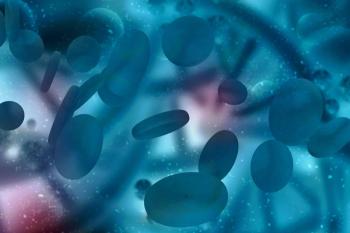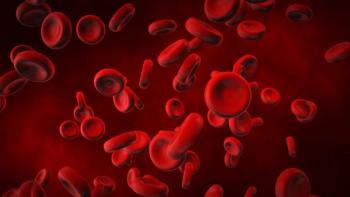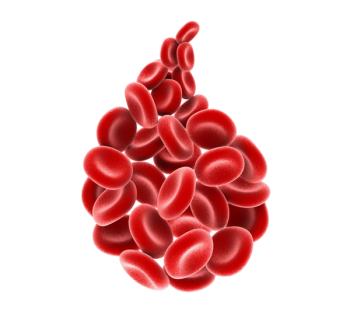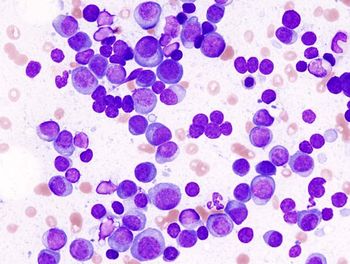
Linvoseltamab Receives EU Approval for Relapsed/Refractory Multiple Myeloma
The EU approval was based on results from the phase 1/2 LINKER-MM1 trial assessing the efficacy of linvoseltamab in relapsed/refractory multiple myeloma.
Linvoseltamab (Lynozyfic) has received conditional marketing approval in the EU as a treatment for adult patients with relapsed/refractory multiple myeloma who have progressed after at least 3 prior therapies, including a proteasome inhibitor, an immunomodulatory agent, and an anti-CD38 monoclonal antibody, according to a news release from the drug’s developer, Regeneron Pharmaceuticals, Inc.1
Previously, the Committee for Medicinal Products for Human Use (CHMP)
The Prescription Drug User Fee Act (PDUFA) target action date is July 10, 2025 in the US.
Results from the phase 1/2 LINKER-MM1 trial (NCT03761108) published in the Journal of Clinical Oncology supported the EU approval.5 After a median follow-up of 14.3 months (range, 0.2-38.4) among patients treated with 200 mg of linvoseltamab (n = 117), the objective response rate (ORR) was 70.9%, with 63.2% of patients achieving a very good partial response (VGPR) or better, and 49.6% achieving a complete response (CR) or better. Additionally, among those assigned to receive 200 mg of linvoseltamab who attained a CR and were evaluable for minimal residual disease (MRD; n = 21), the MRD negativity rate was 90.5% at a threshold of 10-5.
“Despite treatment advances, patients with multiple myeloma inevitably [have] relapses, reduced responses to subsequent therapies, and increasingly shorter remissions. For those who develop relapsed [or] refractory disease after having been exposed to the 3 major drug classes, it’s important to have new therapies with different mechanisms of action like linvoseltamab,” Paula Rodriguez-Otero, MD, hematologic oncologist and medical coordinator of the Central Unit for Clinical Trials at the Cancer Center Clínica Universidad de Navarra, Pamplona, in Navarra, Spain, said in the news release on the EU approval.1 “In a clinical trial, linvoseltamab demonstrated compelling and impressive efficacy with the potential for [CR] in this patient population, including those with high disease burden. Furthermore, its response-adapted schedule will provide patients a convenient treatment option.”
Patients with relapsed/refractory multiple myeloma in the phase 1/2 first-in-human trial were randomly assigned (1:1) to receive either 200 mg (n = 117) or 50 mg (n = 104) of linvoseltamab. A total of 12 patients underwent treatment with 200 mg of the agent during the phase 1 portion of the trial, and 105 were treated with 200 mg of the agent during the phase 2 portion. As of data cut-off, the median duration of treatment in the 200 mg and 50 mg arms were 53.0 weeks vs 13.9 weeks.
In the phase 2 portion of the trial, step-up dosing occurred on days 1 and 8 of the study, consisting of 5 mg and 25 mg of intravenous linvoseltamab. Then, from weeks 3 through 14, 50 mg or 200 mg of linvoseltamab was dosed weekly, and starting week 16, bi-weekly dosing occurred. Patients treated with 200 mg transitioned to dosing every 4 weeks if they achieved a VGPR or better and were treated for a minimum of 4 weeks.
The primary end point of the phase 2 trial was ORR. Secondary end points included duration of response, progression-free survival, MRD negativity rate, overall survival, pharmacokinetics, and safety.
Among patients treated with 200 mg of linvoseltamab, 100% experienced treatment-emergent adverse effects (TEAEs). Additionally, 73.5% experienced grade 3 or 4 TEAEs. The most common hematologic TEAEs included neutropenia (any grade: 42.7%; grade 3 or 4: 41.9%) and anemia (38.5%, 30.8%). Furthermore, common non-hematologic TEAEs included cytokine release syndrome (CRS; 46.2%, 0.9%), diarrhea (37.6%, 1.7%), cough (36.8%, 0%), and arthralgia (29.9%, 0%).
References
- Lynozyfic™ (linvoseltamab) approved in the European Union for the treatment of relapsed/refractory multiple myeloma. News release. Regeneron Pharmaceuticals, Inc. April 28, 2025. Accessed April 29, 2025. https://tinyurl.com/yc3yj9zb
- Linvoseltamab recommended for EU approval by the CHMP to treat relapsed/refractory multiple myeloma. News release. Regeneron. February 28, 2025. Accessed April 29, 2025. https://tinyurl.com/25zb63cs
- Linvoseltamab BLA accepted for FDA review for the treatment of relapsed/refractory multiple myeloma. News release. Regeneron Pharmaceuticals. February 11, 2025. Accessed April 29, 2025. https://tinyurl.com/y7hjbdub
- Regeneron provides update on biologics license application for linvoseltamab. News release. Regeneron Pharmaceuticals, Inc. August 20, 2024. Accessed April 29, 2025. https://tinyurl.com/2u2pvw82
- Bumma N, Richter J, Jagannath S, et al. Linvoseltamab for treatment of relapsed/refractory multiple myeloma. J Clin Oncol. 2024;42(22):2702-2712. doi:10.1200/JCO.24.01008
Newsletter
Stay up to date on recent advances in the multidisciplinary approach to cancer.

















































































